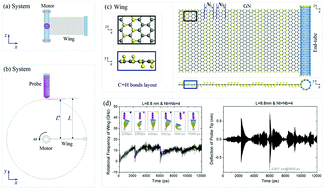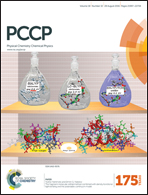Rotation measurements of a thermally driven rotary nanomotor with a spring wing†
Abstract
Due to the extremely small dimensions and super high frequency of the rotor in a thermally driven rotary nanomotor made from carbon nanostructures, measuring the rotational frequency of the nanomotor is still an open issue. To this end, a measuring system is constructed in which a spring wing is connected with the rotor to provide collisions with a probe tip whose deflection reflects the rotational frequency of the rotor. The spring wing is formed by connecting an end-tube from a carbon nanotube and a graphene with differently hydrogenated surfaces. Due to the alternative hydrogenation of the two surfaces, the graphene shrinks like a spring. When the rotational frequency increases, the centrifugal force applied on the wing increases and then the spring is stretched (becoming longer). As the end-tube rotates with the rotor and reaches the probe tip, a collision occurs between the end-tube and the probe tip. After collision, the probe tip undergoes a variation of vertical deflection that can be measured through atomic force microscopy. The relation between the maximal deflection of the probe tip and the rotational frequency of the rotor is determined via numerical experiments. The effects of the configuration (namely hydrogenation and length) of graphene on the rotation of the rotor are investigated. The results provide some insight into the fabrication of nanomachines.


 Please wait while we load your content...
Please wait while we load your content...